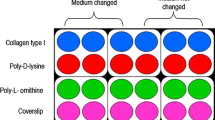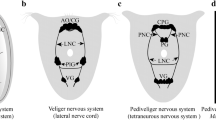Summary
Peptidergic neurons dissociated from the neurosecretory cell group, the X-organ, of adult crabs (Cardisoma carnifex) show immediate outgrowth on unconditioned plastic dishes in defined medium. Most of the neurons can be categorized as small cells, branchers or veilers. A fourth type, “superlarge,” found occasionally, has a soma diameter greater than 40 μm and multipolar outgrowth. We report here the effects on morphology that follow alterations of the standard defined culturing conditions. The three common types of neurons are present when cells are grown in crab saline or saline with l-glutamine and glucose (saline medium). Changes of pH between 7.0 to 7.9 have no effect. Osmolarity changes cause transient varicosities in small cells. In some veilers, pits rapidly appear in the veil and then disappear within 35 min. In cultures at 26° C instead of 22° C, veilers extend processes from the initial veil in a pattern similar to branchers, and the processes of adjacent veilers sometimes form appositions. Culturing in higher [K+]o medium ([K+]o=15–110 mM; standard=11 mM) has no long-term effect, but growth is arrested by [K+]o greater than 30 mM. Cultures were also grown in media in which [Ca2+]o ranged from 0.1 μM to 26 mM (standard=13 mM). Outgrowth occured from all neuronal types in all [Ca2+]o tested. Thus, the expression of different outgrowth morphologies occurs under a wide variety of culturing conditions.
Similar content being viewed by others
References
Aletta J, Greene LA (1988) Growth cone configuration and advance: a time-lapse study using video-enhanced differential interference contrast microscopy. J Neurosci 8:1425–1535
Anglister L, Farber IC, Shahar A, Grinvald A (1982) Localization of voltage-sensitive calcium channels along developing neurites: their possible role in regulating neurite elongation. Dev Biol 94:351–365
Belardetti F, Schacher S, Siegelbaum SA (1986) Action potentials, macroscopic and single channel currents recorded from growth cones of Aplysia neurones in culture. J Physiol (Lond) 374:289–313
Campenot RB (1986) Retraction and degeneration of sympathetic neurites in response to locally elevated potassium. Brain Res 399:357–363
Campenot RB, Dracker DD (1989) Growth of sympathetic nerve fibers in culture does not require extracellular calcium. Neuron 3:733–743
Cohan CS, Connor JA, Kater SB (1987) Electrically and chemically mediated increases in intracellular calcium in neuronal growth cones. J Neurosci 7:3588–3599
Cole WH (1940) The composition of fluids and sera of some marine animals and of the sea water in which they live. J Gen Physiol 23:575–584
Connor JA (1986) Digital imaging of free calcium changes and spatial gradients in growing processes of single mammalian central nervous system cells. Proc Natl Acad Sci USA 83:6179–6183
Connor JA, Tseng H-Y, Hockberger PE (1987) Depolarization-and transmitter-induced changes in intracellular Ca2+ of rat cerebellar granule cells in explant cultures. J Neurosci 7:1384–1400
Cooke IM, Sullivan RE (1982) Hormones and neurosecretion. In: Bliss DE (ed) The biology of Crustacea, vol 3. Academic Press, New York, pp 205–290
Cooke IM, Graf RA, Grau S, Haylett B, Meyers D, Ruben P (1989) Curstacean peptidergic neurons in culture show immediate outgrowth in simple medium. Proc Natl Acad Sci USA 86:402–406
Dagan D, Levitan IB (1981) Isolated identified Aplysia neurons in cell culture. J Neurosci 1:736–740
Dailey M, Bridgman P (1989) Dynamics of the endoplasmic reticulum and other membranous organelles in growth cones of cultured neurons. J Neurosci 9:1897–1909
Dircksen H, Webster SG, Keller R (1988) Immunocytochemical demonstration of the neurosecretory systems containing putative moult-inhibiting hormone and hyperglycemic hormone in the eyestalk of brachyuran crustaceans. Cell Tissue Res 251:3–12
Fatt P, Katz B (1952) Spontaneous subthreshold activity at motor nerve endings. J Physiol (Lond) 117:109–128
Forscher P, Kaczmarek LK, Buchanan J, Smith SJ (1987) Cyclic AMP induces changes in distribution and transport of organelles within growth cones of Aplysia bag cell neurons. J Neurosci 7:3600–3611
Gallo V, Kingsbury A, Balázs R, Jørgensen O (1987) The role of depolarization in the survival and differentiation of cerebellar granule cells in culture. J Neurosci 7:2203–2213
Goldberg D (1988) Local role of Ca2+ in formation of veils in growth cones. J Neurosci 8:2596–2605
Graf RA, Cooke IM (1990) Primary culture of crustacean stomatogastric ganglion neurones in a defined medium. J Exp Biol 149:521–525
Grinvald A, Farber IC (1981) Optical recording of calcium action potentials from growth cones of cultured neurons with a laser microbeam. Science 212:1164–1167
Hockberger PE, Tseng H-Y, Connor JA (1987) Immunocytochemical and electrophysiological differentiation of rat cerebellar granule cells in explant cultures. J Neurosci 7:1370–1383
Hume RI, Role LW, Fischbach GD (1991) Acetylcholine release from growth cones detected with patches of acetylcholine receptor-rich membranes. Nature 305:632–634
Ivins JK, Raper JA, Pittman RN (1991) Intracellular calcium levels do not change during contact-mediated collapse of chick DRG growth cone structure. J Neurosci 11:1597–1608
Kater SB, Mills LR (1991) Regulation of growth cone behavior by calcium. J Neurosci 11:891–899
Kleinfeld D, Raccuia-Behling F, Chiel HJ (1990) Circuits constructed from identified Aplysia neurons exhibit multiple patterns of persistent activity. Biophys J 57:697–715
Kostenko M, Tretjak N, Musienko V (1982) The effect of elevated potassium on the adult mollusc giant neurone survival and neurite formation in culture. Brain Res 236:183–192
Kostenko M, Musienko V, Smolikhina T (1983) Ca2+ and pH affect neurite formation in cultured mollusc isolated neurons. Brain Res 276:43–50
Krenz WD, Principe F del, Fischer P (1990) Crustacean nerve cells in primary culture. In: Frontiers in crustacean neurobiology. Advances in life sciences. Birkhäusen. Basel, pp 509–515
Lankford KL, Letourneau PC (1989) Evidence that calcium may control neurite outgrowth by regulating the stability of actin filaments. J Cell Biol 109:1229–1243
Lipscombe D, Madison DV, Poenie M, Reuter H, Tsien RY, Tsien RW (1988) Spatial distribution of calcium channels and cytosolic calcium transients in growth cones and cell bodies of sympathetic neurons. Proc Natl Acad Sci USA 85:2398–2402
Mangerich S, Keller R, Dircksen H (1986) Immunocytochemical identification of structures containing putative red pigment-concentrating hormone in two species of decapod crustaceans. Cell Tissue Res 245:377–386
Mateus A (1988) Microtubule-associated proteins: their potential role in determining neuronal morphology. Annu Rev Neurosci 11:29–44
Mattson MP, Taylor-Hunter A, Kater SB (1988) Neurite outgrowth in individual neurons of a neuronal population is differentially regulated by calcium and cyclic AMP. J Neurosci 8:1704–1711
Meyers DER, Cooke IM (1991) Regional distribution of ion channels in a cultured crustacean peptidergic neuron. Neurosci Abstracts 17:1335
Meyers DER, Graf RA, Cooke IM (1992) Ionic currents of morphologically distinct peptidergic neurons in defined culture. J Peurophysiol 67:1301–1315
Miledi R, Thies R (1971) Tetanic and post-tetanic rise in frequency of miniature end-plate potentials in low-calcium solutions. J Physiol (Lond) 212:245–257
Mills LR, Kater SB (1990) Neuron-specific and state-specific differences in calcium homeostasis regulate the generation and degeneration of neuronal architecture. Neuron 4:149–163
Newcomb RW (1987) Amino acid sequences of neuropeptides in the sinus gland of the land crab Cardisoma carnifex: a novel neuropeptide proteolysis site. J Neurochem 49:574–583
Nicholls JG, Liu Y, Payton BW, Kuffler DP (1990) The specificity of synapse formation by identified leech neurones in cultures. J Exp Biol 153:141–154
Nishi R, Berg D (1981) Effect of high K+ concentrations on the growth and development of ciliary ganglion neurons in cell culture. Dev Biol 87:301–307
Ochs S, Gaziri J, Jersild R Jr (1986) Metabolic and ionic properties of axoplasmic transport in relation to its mechanism. In: Iqbal Z (ed) Axoplasmic transport, CRC, Boca Raton, Florida, pp 57–68
O'Lague PH, Obata K, Claude P, Furshpan EJ, Potter DD (1974) Evidence for cholinergic synapses between dissociated rat sympathetic neurons in cell culture. Proc Nat Acad Sci USA 71:3602–3606
Perry RJ, McNaughton PA (1991) Calcium regulation in neurons: transport processes. Curr Opinion Neurobiol 1:98–104
Postek MT, Howard KS, Johnson AH, McMichael KL (1980) Scanning electron microscopy — a student's handbook. Ladd Research Industries Inc, Burlington, Vermont
Ross WN, Aréchiga H, Nicholls JG (1987) Optical recording of calcium and voltage transients following impulses in cell bodies and processes of identified leech neurons in culture. J Neurosci 7:3877–3887
Ross WN, Aréchiga H, Nicholls JG (1988) Influence of substrate on the distribution of calcium channels in identified leech neurons in culture. Proc Natl Acad Sci USA 85:4075–4078
Schooneveld H, Herp F van, Minnen J van (1987) Demonstration of substances immunologically related to the identified arthropod neuropeptides AKH/RPCH in the CNS of several invertebrate species. Brain Res 406:224–232
Silver RA, Lamb AG, Bolsover SR (1989) Elevated cytosolic calcium in the growth cone inhibits neurite elongation in neuroblastoma cells: correlation of behavioral states with cytosolic calcium concentration. J Neurosci 9:4007–4020
Silver RA, Lamb AG, Bolsover SR (1990) Calcium hotspots caused by l-channel clustering promote morphological changes in neuronal growth cones. Nature 343:751–754
Stuenkel EL (1985) Simultaneous monitoring of electrical and secretory activity in peptidergic neurosecretory terminals of the crab. J Physiol (Lond) 359:163–187
Stuenkel EL, Cooke IM (1988) Electrophysiological characteristics of peptidergic nerve terminals correlated with secretion. Curr Top Neuroendocrinol 9:123–150
Suarez-Isla BA, Pelto DJ, Thompson JM, Rapoport SI (1984) Blockers of calcium permeability inhibit neurite extension and formation of neuromuscular synapses in cell culture. Dev Brain Res 14:263–270
Sussdorf WS, Campenot RB (1986) Influence of the extracellular potassium environment on neurite growth in sensory neurons, spinal cord neurons and sympathetic neurons. Dev Brain Res 25:43–52
Syed NI, Bulloch AGM, Lukowiak K (1990) In vitro reconstruction of the respiratory central pattern generator of the mollusk Lymnaea. Science 250:282–285
Thomas WE, Jordan FL, Townsel JG (1987) The status of the study of invertebrate neurons in tissue culture-phylum Arthopoda. Comp Biochem Physiol 87A:215–222
Tolkovsky AM, Walker AE, Murrell RD, Suidan HS (1990) Ca2+ transients are not required as signals for long-term neurite outgrowth from cultured sympathetic neurons. J Cell Biol 110:1295–1306
Young SH, Poo M (1991) Spontaneous release of transmitter from growth cones of embryonic neurones. Nature 305:634–637
Author information
Authors and Affiliations
Rights and permissions
About this article
Cite this article
Grau, S.M., Cooke, I.M. Peptidergic neurons of the crab, Cardisoma carnifex, in defined culture maintain characteristic morphologies under a variety of conditions. Cell Tissue Res 270, 303–317 (1992). https://doi.org/10.1007/BF00328016
Received:
Accepted:
Issue Date:
DOI: https://doi.org/10.1007/BF00328016




